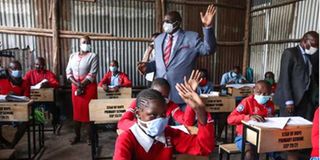New school opening date presents 2021 transition headache

Education Cabinet Secretary George Magoha assesses the learning situation at Star of Hope Primary School in Lunga Lunga, Nairobi, on November 2, 2020.
What you need to know:
- The main transition points are at PPI, Grade 4 and Form One.
- Grade 4 learners will complete their third term on March 19 but the spaces for Grade 5 will still be occupied by the current class (Standard 5).
The rescheduled reopening of primary and secondary schools has set the stage for a transition headache for education planners.
With 2020 essentially a lost year, learners will find themselves in the same class when schools reopen in January as they had just finished a single term.
However, when Grade 4, Standard 8 and Form 4 learners resume after a one-week Christmas break, they will be in their third and last term. Since they will be a term ahead of the others, this will create a transition headache.
At the base of the education system ladder, about 1.5 million three and four-year-olds will be waiting on the wings to join school for the first time.
The only hitch that might delay their entry is that the current Pre-primary One (PPI) learners will still be in the same class, having only been there briefly this year. Most of them are likely to start from scratch, having barely developed any literacy or numeracy skills.
The main transition points are at PPI, Grade 4 and Form One. Grade 4 learners will complete their third term on March 19 but the spaces for Grade 5 will still be occupied by the current class (Standard 5).
Although the candidates will transition to secondary school, teachers will be overwhelmed by the crash programme that might involve teaching in split groups to observe social distancing.
After the candidates sit their KCPE exams, it is not clear how they will proceed to secondary school as the current Form Ones will still be in the same class, having only spent two months in school before the closure.
The possibility of having two Form One classes is real although the numbers work against the plan. The Form Fours will leave 751,150 spaces but KCPE candidates are 1,187,517.
Safety of children
“We’ll be advised on what to do or invited to give our input in order to reach an agreeable time by which all learners should be at the same level,” Kenya Primary Schools Heads Association chairman Nicholas Gathemia told the Nation.
He said the safety of children is paramount and expressed fear that if the government does not improve infrastructure in primary schools, they would be unable to enforce social distancing and congestion would overwhelm them.
President Uhuru Kenyatta directed MPs to engage the National Government Constituency Development Fund in their regions to prioritise the provision of hand washing points in schools, face masks, sanitisers and social distancing.
“All basic education classes resume in-person learning in January of 2021. To foster the State’s preparedness towards reopening of all classes, in our learning institutions in January, I urge and encourage MPs to engage their respective NGCDF boards with a view of finding ways to augment the existing interventions that are geared towards the reopening of our schools,” he said.
Learners in private schools who have been going on with virtual lessons will have to repeat classes as progression to the next ones is not possible. Standard 7 learners, for example, cannot go to Standard 8 since they cannot be registered for KCPE until the others catch up.
Most of the schools that transitioned to online lessons have actually covered the syllabus for the year and will be closing this month.
Also likely to stay out of school longer are the Form Fours. Unless universities and middle-level colleges undertake crash programmes, there will be no space to accommodate the new school leavers. First Years at universities only reported last month while there is still another First Year cohort in its last semester.
There might be a need to reorganise the curriculum so that the content remaining for the current year and the next class are all taught in 2021 to avoid losing more time. This would be done by the Kenya Institute of Curriculum Development.




